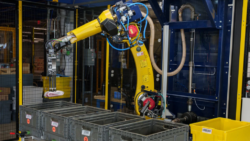Amazon’s new Sparrow robot can recognise millions of products and replace humans at repetitive work (Credit: Amazon)
Amazon has revealed the latest addition to its workforce: a robot called ‘Sparrow’.
In what could spell the beginning of the end for human workers in Amazon’s vast warehouses, the robot is capable of recognising ‘millions of items’.
According to Amazon, it can ‘detect, select and handle individual products’ and therefore reduce many of the repetitive tasks that flesh-and-blood humans have to do.
Although the tech giant hasn’t announced any major layoffs in the same way as Meta and Twitter, it is struggling. This week, Amazon became the first company in history to lose $1 trillion.
So, naturally, replacing people with robots is one way of cutting costs when it comes to logistics.
‘In our current research and development efforts, we are working with Sparrow to consolidate inventory before it is packaged for customers,’ said Xavier Van Chau, a spokesperson for the company, ‘but the possible applications of this technology in our operations is much broader.’
A worker gathers items for delivery from the warehouse floor at Amazon’s distribution center in Phoenix, Arizona (Credit: Reuters)
Amazon is steering clear of any suggestion the robot will replace employees at this point. In fact, it’s saying the addition of robotics has created 700 new categories of jobs within the company.
‘These new types of roles, which employ tens of thousands of people across Amazon, help tangibly demonstrate the positive impact technology and robotics can have for our employees and for our workplace,’ the company said in a blog post.
‘Supporting our employees and helping them transition and advance their career into roles working with our technology is an important part of how we will continue to innovate.’
There’s another good reason Amazon is keen to increase its robotic assistance – it may actually run out of people to hire.
An internal company research memo, obtained by Vox in June, stated bluntly: ‘If we continue business as usual, Amazon will deplete the available labor supply in the US network by 2024.’
Amazon says that robotics has created 700 new job categories in the business (Credit: Amazon)
That’s because the turnover at Amazon’s huge warehouses is staggeringly high. In 2019, the company had a US warehouse staff attrition rate of 123%.
While many workers may simply see their time in an Amazon warehouse as a stopgap on their way to bigger and better things, there are also many who quit over the stringent working conditions.
But it could well be the case there just aren’t enough people around to fill those jobs in the coming years.
It should be noted that the company quickly dismissed the contents of the memo when questioned directly.
In a statement sent to Metro.co.uk, an Amazon spokesperson said: ‘There are many draft documents written on many subjects across the company that are used to test assumptions and look at different possible scenarios, but aren’t then escalated or used to make decisions.
‘This was one of them.
‘It doesn’t represent the actual situation, and we are continuing to hire well in Phoenix, the Inland Empire, and across the country.’
Either way, it’s not the only company looking to move into robots and automation.
Tesla is doing the same.
Tesla is also making robots (Credit: Getty Images)
Elon Musk’s electric car company presented a prototype of the robot – which it calls Optimus – to a crowd at Tesla’s office in Palo Alto, California last month.
The robot slowly and awkwardly walked onto a stage, turned, and waved to the audience who cheered.
Mr Musk said he planned to produce millions of the humanoids and sell them for less than £18,000, a third of the price of Tesla’s Model Y car.
The robot has been created with four fingers and a thumb so it can have the dexterity of humans.
Mr Musk wants Optimus to be able to help people with basic chores such as cooking or even with caring for relatives.
Whether or not it’ll end up in an Amazon warehouse as well remains to be seen.
MORE : Amazon becomes first company in history to lose $1,000,000,000,000
MORE : Amazon faces $1,000,000,000 lawsuit in UK for ‘favouring its own products’
Say hello to ‘Sparrow’.





